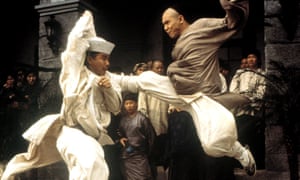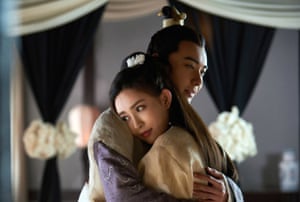
A Hero Born by Jin Yong review – the gripping world of kung fu chivalry
The martial arts epic Legends of the Condor Heroes is the magnum opus of China’s most widely read living writer. The first book has finally been translated into English, and it’s a joy
Jin Yong is an unfamiliar name in the English-speaking world but a superstar in the Chinese-speaking one. Since his first novels were published in serial form in Hong Kong during the 1950s, Jin Yong – the pen name of Louis Cha Leung-yung – has become the most widely read Chinese writer alive. His books have been adapted into TV series, films and video games, and his dense, immersive world inspires the kind of adoration bestowed on those created by writers like western worldbuilders such as JRR Tolkien, JK Rowling and George RR Martin.
One peep into Jin’s fictional universe conjures a sense of deja vu. Now 94, he is the most famous literary exponent of the wuxia genre, the world of kung fu chivalry we know through Chinese martial arts movies, which has shaped so much of modern popular culture, from The Matrix to Netflix’s Marco Polo.

A scene from Once Upon a Time in China … Jin Yong is the most famous literary exponent of wuxia, the world of kung fu chivalry familiar from martial arts movies. Photograph: Everett Collection/Rex Features
A Hero Born is the first book of Jin’s magnum opus, the 12-volume epic Legends of the Condor Heroes. Set in 13th-century China, this novel follows the fortunes of its hero, Guo Jing, from birth to adolescence. It begins with Guo in utero, when his father is murdered by forces loyal to the occupying Jin army and his pregnant mother flees to Mongolia. Here, on the fringes of the Middle Kingdom, Guo grows up among Genghis Khan’s nomadic warriors, while the Seven Heroes of the South, who have sworn an oath to train him in martial arts, scour the country to find him.
A Hero Born is the first book of Jin’s magnum opus, the 12-volume epic Legends of the Condor Heroes. Set in 13th-century China, this novel follows the fortunes of its hero, Guo Jing, from birth to adolescence. It begins with Guo in utero, when his father is murdered by forces loyal to the occupying Jin army and his pregnant mother flees to Mongolia. Here, on the fringes of the Middle Kingdom, Guo grows up among Genghis Khan’s nomadic warriors, while the Seven Heroes of the South, who have sworn an oath to train him in martial arts, scour the country to find him.
The hero Guo Jing in a 2017 TV adaptation of Jin Yong’s Legends of the Condor Heroes epic.
A plot summary barely conveys the extraordinary energy of this book. It blends real and fictional characters, teems with incident – reversals, unexpected meetings, betrayals, cliffhangers – and, most of all, dwells for page after page on lovingly described combat. To paraphrase Miss Jean Brodie: for those of us who like this sort of thing, this is the sort of thing we like. As martial artists square off, evocatively named strikes are responded to with equally evocatively named parries: Search the Sea, Behead the Dragon; Seize the Basket by the Handle; and, only to be used in extremis, the desperation move: Sword of Mutual Demise. The novel gives us the history of strange martial techniques, assesses the merits of different schools of kung fu, and describes the mysterious internal alchemy that gives rise to the most devastating physical force.
Guo is naive and not particularly gifted – a wink, perhaps, at the idea of the uncarved block in the Tao Te Ching: the natural object of unlimited potential. But his innocent goodheartedness – another Taoist ideal – makes him a captivating hero. He’s surrounded by a galaxy of colourful minor characters. These include Ke Zhen’e, a blind martial artist who shoots his signature weapon – iron devilnuts – by orienting himself according to directions from the I Ching; Lotus Huang, a brilliant young female fighter travelling the country in disguise, and a terrifying female villain called Twice Foul Dark Wind, who is the greatest exponent of Nine Yin Skeleton Claw kung fu, a martial discipline that is nastier than it sounds. Everybody is kung fu fighting, but the violence is cartoonish rather than graphic and there is a sense – as with Rowling and Tolkien – that despite the strangeness of the world, we are guided by a compassionate writer whose heart is in the right place. The book also reminds us of the true meaning of kung fu (the Pinyin transliteration is gongfu). Rather than being an esoteric gift, it applies to any skill acquired by hard graft. It seems you can have kung fu at making puff pastry or writing computer code. “Just as in the study of music or chess, demanding fast results can choke initial promise,” the author warns us. His explanation reminded me of the 10,000 hours of practice that, according to Malcolm Gladwell, are the basis for expertise at anything.
Jin Yong is not the first wuxia writer: its roots go back centuries. Writing his books, he has drawn both on Chinese history and also on the examples of less celebrated writers, such as the novelist and martial artist Xiang Kairan, whose work inspired the lost 27-hour 1928 kung fu film, The Burning of the Red Lotus Temple. Fortified by this tradition and written with unselfconscious energy, A Hero Born channels mythic archetypes that resonate across cultures: the struggle between good and evil, a kingdom under threat from an encroaching tyranny, and the coming to consciousness of a young hero whose destiny is to try to make a better world.
It seems incredible that this is the first book in the Legends of the Condor Heroes series to come out in English, but better late than never. As I read Anna Holmwood’s vibrant translation – gripped by the unashamed narrative zest and primary-coloured fairytale world – I felt a slight regret that I was coming to this novel in my fifth decade. It would be a wonderful initiation into a lifelong enthusiasm for China, its history and civilisation, its vast and chronically misunderstood presence in the world. The first book ends with Guo Jing embroiled in an incipient love triangle, and approaching the trial by combat that has been his destiny since birth, while the Song dynasty dangles by a thread. Other volumes can’t come soon enough. My one quibble is that as the heroes swept back and forth across China and the Mongolian steppe, this reader’s pleasure would have been greatly enhanced by a map.
•

No comments:
Post a Comment